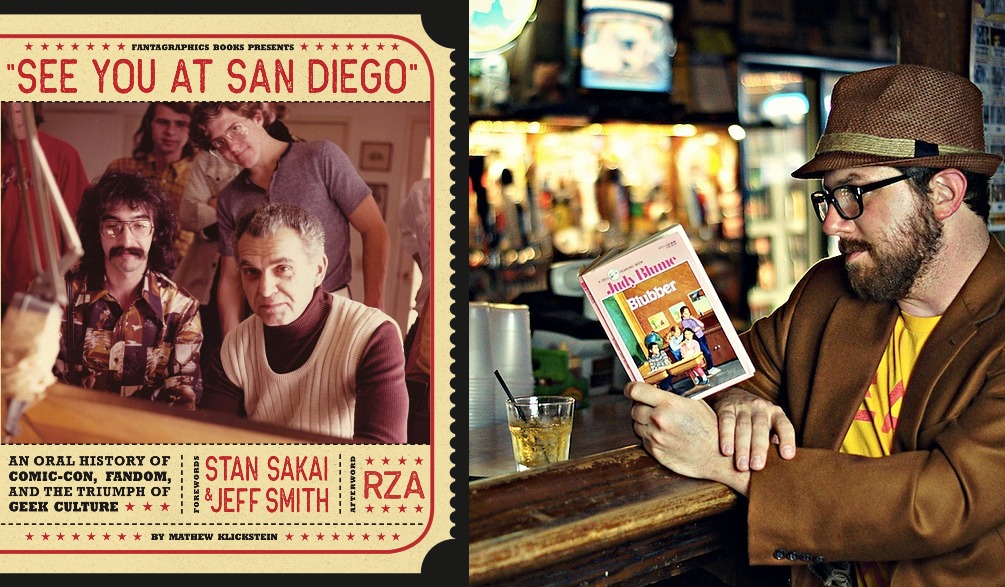
Mathew Klickstein had a dream: To publish an oral history of San Diego Comic-Con that preserved the collective memory of the event.
Klickstein interviewed dozens of people who’d been part of Comic-Con over its half-century as a hub of pop culture fandoms. He talked to its cofounders and interviewed artists and writers, actors and filmmakers.
And when he was ready to send it to publishers, well, the world turned upside down. The pandemic, which kept San Diego Comic-Con from taking place in person for three years, also prompted Klickstein to transform his 70-plus hours of interviews into a Sirius XM podcast.
“Comic-Con Begins: Origin Stories of the San Diego Comic-Con and the Rise of Modern Fandom” arrived in July 2021 to accompany the return of Comic-Con@Home, the virtual Con created during the pandemic pause.
And that might have been that, except Klickstein refused to let it be.
“See You at San Diego: An Oral History of Comic-Con, Fandom, and the Triumph of Geek Culture” arrived in bookstores on Tuesday, Sept. 6. It’s an impressive volume from Fantagraphics Books, the publisher of alternative comics, collections of classic comic strips, graphic novels, and more.
It makes Klickstein emotional as he recalls the first time he held a physical copy in his hands.
“I’m tearing up right now thinking about it,” he says. “This has been such an important part of my life for the last three years. And they were three exceptionally tumultuous years. Like a lot of people, I lost people during the pandemic. Like, a lot of people, I went through some really frightening moments personally, professionally, economically.
“One of the things that kept me going and revivified me through all this was working on telling the story of how Comic-Con happened,” Klickstein says. “And how geek culture both supported it before, during and after, and was supported by it in the last decade or two.”
“It’s quite a doorstop,” he says of the 475-page book, which weighs three-and-a-half pounds and includes more than 400 photographs. “It’s something hopefully beyond its size and scope that will hit folks pretty hard.”
Bookmaking
Though the podcast was about seven hours long, Klickstein had recorded 70 hours of interviews and estimates that 90 percent of that material is included in “See You at San Diego.”
“In a lot of ways, it’s an extended director’s cut of the podcast,” he says. “And then the added bonus was all of the photos and art. That’s what the book is.”
Fantagraphics designer Jonathan Barli took Klickstein’s text, photos and art and shaped into a fun, creative package. If you turn the book sideways and riffle the pages it looks as if you’re flipping through manila file folders with the chapter titles on the tabs.
Unlike the podcast, where those speaking weren’t always identified, here they are identified by name and job or title – “Scott Shaw, co-founder,” “Barry Alfonso, co-founder/publicity director” – with longer bios in the back of the book.
And the photographs and art Klickstein gathered provide mostly never-before-seen images of Comic-Con throughout its history, with an emphasis on the lesser-known earlier years.
“I worked very hard on the photos and art that I acquired, how I curated it, where we put everything,” Klickstein says. “Just like the book itself, I didn’t want it to be a straightforward generic start to finish. I wanted it to feel like a comic convention itself.”
That means there might be a black and white photo from the pre-history of the Con alongside a more modern color photograph, he says. The images should work together because of the linkages in the accompanying narrative.
“It’s a lot of what the convention and the culture itself is about,” Klickstein says. “Where you can have ‘Star Wars’ and ‘Star Trek,’ and comic books and ‘Twilight’ and the ‘Twilight Zone,’ and everything is happening around you all at once.”
Telling their stories
For Klickstein, a lot of the urgency he felt in finishing the book and getting it published was to capture the history of San Diego Comic-Con while as many of its early founders, guests and fans are still alive to share their stories and photographs.
“The most valuable asset I had through this entire process, since Day 1, was the relationships I established with everybody,” he says of the way he won the trust of his sources.
Wendy All, an early committee member and well-known artist, illustrator, writer and toy designer, was the first of those to embrace Klickstein’s vision and offer him entry into her network of Comic-Con friends and colleagues.
“She’s my first acknowledgment, even before my parents and my wife,” he says. “There’s no question that none of this would have happened for me without Wendy All. Wendy was my liaison, telling me who to talk to and connecting me with them. Saying, ‘This is the guy we’ve been waiting for.’
“It’s great talking to these people and to share that joy, what it truly means to be a geek, a nerd, a fan,” Klickstein says. “And give the people who really helped make it happen that showcase they deserve.
“Everyone knows who Kevin Smith is – and Neil Gaiman,” he says of two big-name creators who are part of the oral history. “But not everyone might know who Scott Shaw is or Bjo Trimble or some of the others.”
It was that thought, Klickstein says, that guided him throughout the project.
“I really wanted this to be their story,” he says. “And I’m so incredibly proud of, not only the book, but all the many people who helped to make it happen.”
Related Articles
This week’s bestsellers at Southern California’s independent bookstores
This author wrote from the animals’ perspective for ‘What We Fed to the Manticore’
The Book Pages: Has the airport novel been grounded?
Children’s book giant David Shannon reimagines King Midas as a greedy kid in ‘Gold!’
Annette Chavez Macias’ Inland Empire childhood inspired her novel about Mexican American cousins
